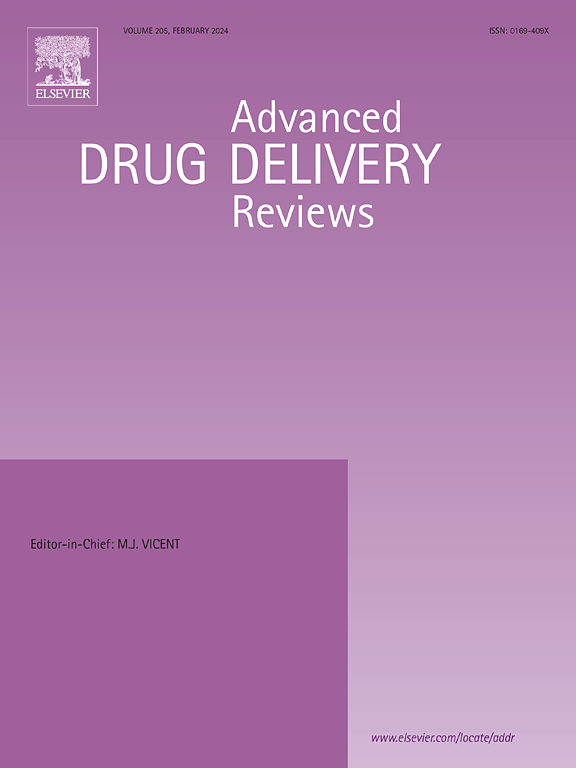3D打印超材料:性能,制造和药物输送应用
IF 17.6
1区 医学
Q1 PHARMACOLOGY & PHARMACY
引用次数: 0
摘要
给药是在正确的时间将适量的药物送到正确的地方,同时最大限度地减少可能的副作用和最大限度地提高有益效果的过程。这是通过药物传递系统(dds)来实现的,它是由各种天然和/或合成材料组成的平台,通过口服、透皮、局部、静脉注射和肌肉注射等途径将药物或生物活性药物携带到特定部位或贯穿患者全身,以最大限度地减少药物的毒性,并在不影响患者健康细胞、组织或器官的情况下提供所需的治疗效果。尽管取得了重大进展,但药物递送仍然面临许多科学、技术和临床挑战,如药物生物利用度差、装载效率不稳定、缺乏位点特异性、不希望延长药物递送时间、缺乏药物稳定性、实现控制和持续释放的局限性、长期有害的毒性和患者依从性。近年来,研究人员创造了“超材料”,利用3D打印技术的进步,展示了自然界中不存在的复杂、可定制的结构特征,通过精确操纵纳米级光物质等广泛相互作用,提供了对药物释放动力学、靶向和有效性的精确控制。本文探讨了利用超材料的力量以前所未有的精度和效率开发先进的dds,重点介绍了超材料,材料选择,设计考虑因素,制造挑战以及生物打印超材料的优化策略。它们最近在药物递送方面的应用解决了与释放系统相关的挑战,包括持续、脉动和按需递送、靶向递送、治疗应用和再生医学,这些也在探索中。我们相信这篇综述将通过强调与生物相容性、可扩展性、制造考虑以及翻译中的障碍或机会相关的挑战,激发这一新兴领域的进一步研究和开发,最终导致个性化医疗和保健的变革性进步。本文章由计算机程序翻译,如有差异,请以英文原文为准。


3D printed metamaterials: properties, fabrication, and drug delivery applications
Drug delivery is a process to deliver the required amount of a drug to a target site within an appropriate timeframe, while minimizing possible side effects and maximizing efficiency. This is accomplished by drug delivery systems (DDSs), which are platforms composed of natural and/or synthetic materials that carry drugs or bioactive agents at a particular site or throughout a patient's body via oral, transdermal, topical, intravenous, or intramuscular routes to minimize the drug’s toxicity and provide desired therapeutic effects without affecting the patient’s healthy cells, tissues or organs. Despite significant advancements, drug delivery still faces numerous scientific, technological, and clinical challenges, such as poor drug bioavailability, unstable loading efficiency, lack of site-specificity, undesired prolonged delivery of drugs. Issues such as drug stability, limitations in achieving controlled and sustained release, long-term unwanted toxicity, and patient compliance are also common challenges in the field. In recent years, researchers have created 'Metamaterials', which exploit the advancements in fabrication and 3D printing technology to exhibit complex characteristics and customizable architecture that are not otherwise naturally present in a material. These properties provide a precision control over drug release kinetics, targeting, and efficiency by precise manipulation of interactions at the nanoscale. This review explores the potential of metamaterials in developing advanced DDSs with exceptional precision and efficacy, via materials selection, design considerations, fabrication challenges, and optimization strategies for 3D printing of these materials. We provide an overview of their recent application in drug delivery tackling the challenges associated with release systems, including sustained, pulsatile, and on-demand delivery modalities. Targeted delivery, theranostic applications, and regenerative medicine, are also explored. We believe this review will inspire further research and development in this burgeoning field by highlighting the challenges associated with their biocompatibility, scalability, manufacturing considerations, and hurdles or opportunities in translation, ultimately leading to transformative advancements in personalized medicine and healthcare.
求助全文
通过发布文献求助,成功后即可免费获取论文全文。
去求助
来源期刊
CiteScore
28.10
自引率
5.00%
发文量
294
审稿时长
15.1 weeks
期刊介绍:
The aim of the Journal is to provide a forum for the critical analysis of advanced drug and gene delivery systems and their applications in human and veterinary medicine. The Journal has a broad scope, covering the key issues for effective drug and gene delivery, from administration to site-specific delivery.
In general, the Journal publishes review articles in a Theme Issue format. Each Theme Issue provides a comprehensive and critical examination of current and emerging research on the design and development of advanced drug and gene delivery systems and their application to experimental and clinical therapeutics. The goal is to illustrate the pivotal role of a multidisciplinary approach to modern drug delivery, encompassing the application of sound biological and physicochemical principles to the engineering of drug delivery systems to meet the therapeutic need at hand. Importantly the Editorial Team of ADDR asks that the authors effectively window the extensive volume of literature, pick the important contributions and explain their importance, produce a forward looking identification of the challenges facing the field and produce a Conclusions section with expert recommendations to address the issues.

 求助内容:
求助内容: 应助结果提醒方式:
应助结果提醒方式:


